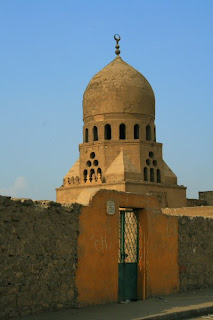City of the Dead
 In the City of the Dead, Turkish generals sleep under marble slabs, while the children of their former subjects live, breathe, work and play above ground, alongside the tombs. Some of Egypt's most significant architecture is here, such as the Mosque of Sultan Qaitbey, its walls backing onto slums where flocks of goats and armies of bare-foot children run between the headstones.
In the City of the Dead, Turkish generals sleep under marble slabs, while the children of their former subjects live, breathe, work and play above ground, alongside the tombs. Some of Egypt's most significant architecture is here, such as the Mosque of Sultan Qaitbey, its walls backing onto slums where flocks of goats and armies of bare-foot children run between the headstones. The City is just past the fringe of inner-city Cairo, on one of the rolling hills that lead up to endless suburbs of low-income concrete blocks, like those you would have seen in the news which collapsed a couple of months ago, killing 82 people.
 Despite it being a cemetery, the main road through it, a (mostly) one-way street, constantly roars with taxis, microbuses, donkeys, school buses. Cafes play the soaps on old tvs, men weld spare car parts together, cats scrounge through rubbish beneath elegant arches and women hang washing out in front of 15th-century mosques, when Egypt was controlled by Mamaluk warlords, then Turkish pashas, and witnessed the rise of of the Albanian mercenary Mohammad Ali.
Despite it being a cemetery, the main road through it, a (mostly) one-way street, constantly roars with taxis, microbuses, donkeys, school buses. Cafes play the soaps on old tvs, men weld spare car parts together, cats scrounge through rubbish beneath elegant arches and women hang washing out in front of 15th-century mosques, when Egypt was controlled by Mamaluk warlords, then Turkish pashas, and witnessed the rise of of the Albanian mercenary Mohammad Ali. Tombstones erupt crazily from the dry earth, set in small courtyards with comfortable banquette seats around their walls, where Egyptian families come on Fridays to hang out with the departed, eating, drinking and letting the kids run riot in what the guide books say is a continuation of the Pharonic tradition of living with the dead.
We stepped into one such courtyard, where the earth was wet and turned - a man had been buried there the day before, my impromptu guide told me: the dead city is still well and truly living.

.jpg)
Thought my eyes deceived me for a sec there Belle. Mohammad Ali Pasha the guy who ruled Egypt till September 1848 and not the guy who rules the boxin ring.
ReplyDeleteThanks for the history lesson!
ah Kev, between me and Wiki, we'll misinform you in the best possible way. Who needs history teachers, eh?
ReplyDelete